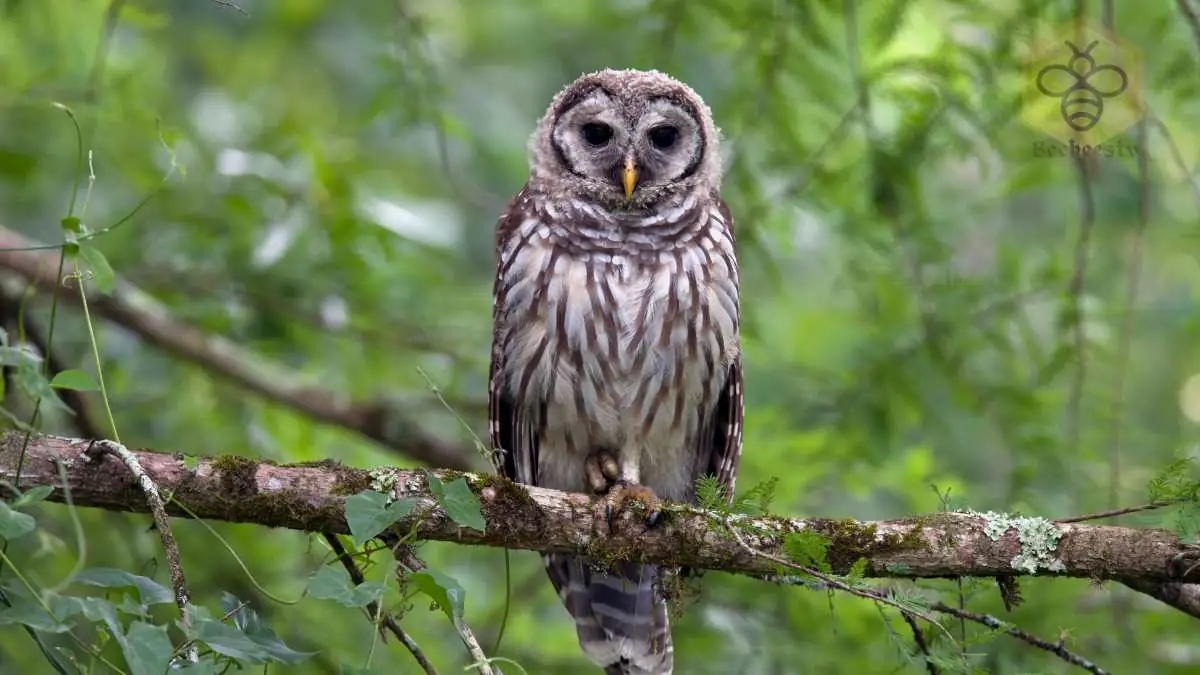Barred Owl: An Icon of North American Forests
Barred Owl
Introduction
The barred owl, with its soulful eyes and distinctive call, is a fascinating bird native to North America’s woodlands. Known for its “Who cooks for you?” hoots, this owl holds a special place in the hearts of nature enthusiasts.
Scientific Overview
Scientific Name
Strix varia
Common Name
Barred Owl
Scientific Classification
| Kingdom | Animalia |
| Phylum | Chordata |
| Class | Aves |
| Order | Strigiformes |
| Family | Strigidae |
| Genus | Strix |
Origin and Distribution
Native Regions
Barred owls are native to North America and can be found in:
- Eastern and Central United States.
- Parts of Canada.
- Pacific Northwest.
Habitat
These owls prefer dense forests, particularly those near water sources such as rivers, swamps, and lakes.
Physical Characteristics
Size and Weight
- Length: 40–63 cm (16–25 inches).
- Wingspan: 96–125 cm (38–49 inches).
- Weight: 500–1050 grams (1.1–2.3 pounds).
Appearance
- Plumage: Mottled brown and white with horizontal bars across the chest and vertical streaks on the belly.
- Eyes: Dark brown, giving it a striking and soulful gaze.
- Beak: Yellow and slightly hooked.
Behavior and Lifestyle
Activity Patterns
Barred owls are primarily nocturnal but may occasionally hunt during the day.
Territorial Nature
They are highly territorial and use their distinctive calls to communicate and defend their space.
Diet and Feeding Habits
What Do They Eat?
Barred owls are carnivorous, with a diet consisting of:
- Small mammals like mice and voles.
- Birds, amphibians, and reptiles.
- Insects and crustaceans.
Hunting Strategy
They use their acute hearing and silent flight to ambush prey, often swooping down from a perch.
Reproduction and Lifespan
Breeding Habits
- Mating Season: Late winter to early spring.
- Monogamy: These owls mate for life.
Nesting
- They nest in tree cavities or use abandoned nests of other birds.
- Females lay 1–5 eggs, which hatch after about 28–33 days.
Lifespan
In the wild, barred owls live up to 10 years, while those in captivity may reach 20 years or more.
Predators and Threats
Natural Predators
- Great horned owls.
- Hawks and eagles.
Human-Related Threats
- Habitat destruction.
- Collisions with vehicles.
Ecological Importance
Role in Ecosystem
Barred owls help regulate populations of small mammals and insects, contributing to ecological balance.
Indicator Species
Their presence can indicate the health of forest ecosystems.
Population and Conservation Status
Current Status
Barred owls have a stable population and are listed as a species of Least Concern by the IUCN.
Conservation Efforts
- Protection of forest habitats.
- Monitoring population trends.
Interesting Facts About Barred Owls
- Why Are They Called Barred Owls?
The name comes from the distinctive horizontal bars on their chest feathers. - Do They Migrate?
Barred owls are generally non-migratory and remain in their territories year-round. - What Makes Their Call Unique?
Their hoot sounds like “Who cooks for you? Who cooks for you all?” - How Do They Fly Silently?
Specialized feathers reduce noise during flight, allowing them to approach prey undetected. - Are They Aggressive?
While not typically aggressive, they will fiercely defend their nests if threatened.
Conclusion
The barred owl is a captivating bird, celebrated for its beauty, haunting calls, and role in maintaining forest ecosystems. By preserving their habitats and respecting their territories, we can ensure these woodland guardians continue to thrive for generations to come.
